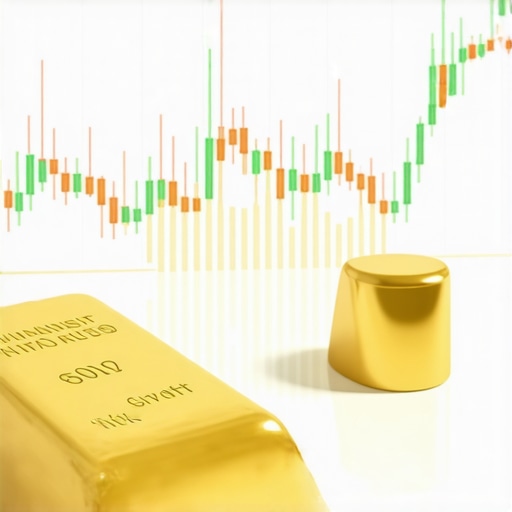Understanding Gold Investment Options for 2025
As we approach 2025, investors are increasingly looking for stable and lucrative investment options to safeguard their financial future. Among the various assets available, gold has consistently stood out as a reliable choice. In this article, we will explore the best gold investment options for investors in 2025, providing insights into why gold remains a coveted asset in today’s volatile market.
Why Invest in Gold?
Gold has been a symbol of wealth and stability for centuries. Its intrinsic value, coupled with its ability to hedge against inflation and economic uncertainty, makes it a favored choice among investors. The growing popularity of physical gold investments is a testament to its enduring appeal. Investors often turn to gold during times of market distress, as it tends to retain its value when other assets may falter.
Types of Gold Investments to Consider
When considering gold investments for 2025, there are several options available, each catering to different investment strategies and risk tolerances:
Physical Gold
Investing in physical gold, such as coins or bars, offers tangible ownership of the asset. This investment is particularly attractive for those who prefer to hold their wealth in a physical form. However, it’s essential to evaluate the key considerations for physical gold investments, including storage and insurance costs.
Gold ETFs
Exchange-Traded Funds (ETFs) that invest in gold provide a more liquid and convenient way to gain exposure to gold prices without the need for physical storage. Gold ETFs track the price of gold and are traded like stocks, making them an excellent option for investors who want to diversify their portfolios with minimal hassle.
Gold Mining Stocks
Investing in gold mining companies can also be lucrative, as these stocks often provide leveraged exposure to gold prices. As gold prices rise, the profitability of mining companies typically increases, leading to potentially significant returns. Conducting thorough research and understanding the factors influencing mining stocks is crucial before investing.
Conclusion
As we look forward to 2025, understanding the best gold investment options can empower investors to make informed decisions. Whether you choose physical gold, ETFs, or mining stocks, each option presents unique benefits and risks. Always consider your investment goals and consult with a financial advisor to determine the best approach for your portfolio.
Evaluating the Best Gold Investment Strategies
As investors gear up for 2025, it’s essential to analyze effective gold investment strategies that align with market trends. One of the critical considerations is understanding gold demand trends and how they influence investment choices. With the shifting economic landscape, being informed about these trends can significantly enhance your investment potential.
Gold Investment Strategies for Risk Management
Implementing sound investment strategies is vital for mitigating risks associated with gold investments. Diversification is a key strategy; by spreading investments across different types of gold assets, such as physical gold, ETFs, and mining stocks, you can protect your portfolio from volatility.
Maximizing Returns on Gold Investments
To maximize returns, it’s crucial to keep an eye on market forecasts and expert opinions. The gold price forecast for 2025 suggests potential growth, making it an opportune time to invest. Understanding the factors that drive gold prices, such as inflation and economic instability, can aid in making informed decisions.
Understanding Gold Market Analysis
Gold market analysis plays a vital role in shaping investment strategies. By examining current price movements and historical data, investors can identify patterns that help predict future trends. This analysis is particularly important for those looking to enter the market with confidence.
Key Players in the Gold Market
Identifying key players in the gold market, including central banks and large mining companies, can provide insights into market dynamics. For example, central bank purchases can significantly impact gold prices. Keeping track of these purchases can serve as a barometer for future price movements. Additionally, understanding how mining companies operate and their production levels can offer valuable insights into the overall supply of gold.
Gold Investment Options for Beginners
For those new to gold investing, starting with beginner-friendly options is advisable. Options like gold ETFs are particularly appealing due to their low barriers to entry and liquidity. They allow investors to gain exposure to gold prices without the complexities of physical ownership.
Physical Gold vs. ETFs
While physical gold offers tangible security, ETFs provide ease of trading and lower storage costs. Weighing the pros and cons of each investment type is crucial. For example, those concerned with long-term wealth preservation might favor physical gold, while those seeking liquidity may opt for ETFs or stocks.
Future of Gold Investments
The future of gold investments looks promising, with trends suggesting an increase in demand as investors seek safe havens. As economic uncertainties persist, gold’s role as a protective asset will likely grow. Staying informed about 2025 gold price forecasts will help investors make strategic decisions.
In conclusion, as you navigate the gold investment landscape for 2025, consider a comprehensive approach that includes market analysis, diversification, and an understanding of the underlying factors influencing gold prices. By doing so, you can position yourself to capitalize on the opportunities that lie ahead.
Diverse Gold Investment Options: Making Informed Choices
As the gold market continues to evolve, investors must explore a variety of gold investment options available today. Understanding these options is crucial for maximizing returns and minimizing risks. Whether you are considering gold ETFs, physical gold, or gold mining stocks, each comes with its own set of benefits and risks. By analyzing these factors, you can make better-informed investment decisions.
Gold ETFs: A Flexible Investment Choice
Gold ETFs are an increasingly popular choice among investors due to their liquidity and ease of trading. They allow you to invest in gold without the need for physical storage, making them ideal for those who prefer a hassle-free approach. Additionally, gold ETFs often have lower expense ratios compared to mutual funds, which can enhance overall returns. For more information on this topic, check out our article on Gold ETFs vs. Gold Mutual Funds.
Investing in Physical Gold: The Tangible Asset Advantage
While gold ETFs offer convenience, many investors still prefer the security of physical gold. Owning tangible assets like gold bars or coins provides peace of mind, particularly during economic uncertainty. Physical gold serves as a hedge against inflation and currency depreciation, making it an attractive option for long-term investors. However, it does come with considerations such as storage costs and insurance. To learn more about the benefits of physical gold, visit Exploring the Benefits of Physical Gold Investments.
Understanding Gold Mining Stocks: Leveraging Market Movements
Investing in gold mining stocks is another avenue to consider, especially for those looking to leverage gold price movements. Mining companies often experience significant stock price appreciation when gold prices rise, providing a potential for high returns. However, investing in mining stocks also comes with inherent risks, including operational challenges and fluctuations in production costs. For insights into the best gold stocks for 2025, explore our Best Gold Stocks for 2025 article.
Gold Mutual Funds: Diversifying Your Gold Portfolio
Gold mutual funds offer another layer of diversification by pooling investors’ money to invest in various gold-related assets, including mining stocks and ETFs. This approach mitigates risks associated with individual asset volatility while allowing exposure to the gold market. For those looking to understand the differences between gold ETFs and mutual funds, our article on Gold ETFs vs. Gold Mutual Funds provides valuable insights.
Long-Term View: Preparing for Future Gold Demand Trends
As you consider your gold investment strategy, it’s essential to adopt a long-term view. The 2025 gold price forecast indicates a potential increase in demand, driven by factors such as economic instability and inflationary pressures. Staying informed about these trends will enable you to adjust your investment strategy effectively.
In conclusion, the diverse gold investment options available today present a wealth of opportunities for investors. By considering your financial goals, risk tolerance, and market trends, you can create a well-rounded gold investment strategy that aligns with your objectives. Whether you choose gold ETFs, physical gold, or mining stocks, ensuring you are well-informed will set you up for success in navigating the gold market in 2025.
Leveraging Gold Market Trends: Insights for Investors
As investors navigate the complexities of the gold market, understanding key trends is essential for making informed decisions. The gold market analysis provides insights into how economic factors, geopolitical events, and market sentiment can influence gold prices. By keeping abreast of these developments, investors can better position themselves to capitalize on market fluctuations.
Economic Factors Impacting Gold Prices
Economic indicators such as inflation rates, interest rates, and currency strength play a significant role in determining the price of gold. For instance, when central banks lower interest rates, gold often becomes a more attractive investment as it does not yield interest. Furthermore, a weakening currency can lead to increased demand for gold as a safe-haven asset. Understanding these correlations is vital for any investor looking to maximize their gold investment strategy.
Geopolitical Events and Gold Demand
Geopolitical tensions and crises have historically driven up gold prices as investors seek safety in tangible assets. Events such as trade wars, military conflicts, and political instability can lead to increased demand for gold. By monitoring current affairs and their potential impact on the market, investors can adapt their strategies accordingly. Our article on how gold can protect against economic uncertainty provides further insights into this relationship.
Strategies for Investing in Gold for 2025
As we look ahead to 2025, developing a robust gold investment strategy is crucial. Here are some effective approaches to consider:
Diversifying Your Gold Investments
Diversification remains a key strategy for minimizing risk and enhancing returns. By investing in a mix of gold assets, including physical gold, gold ETFs, and mining stocks, you can spread risk and benefit from various market dynamics. Our guide on essential gold investment strategies for risk management can help you implement a balanced approach.
Staying Informed with Reliable Market Analysis
Keeping up with market trends and expert analyses is vital for any serious investor. Regularly reviewing articles and reports from trusted sources can equip you with the knowledge necessary to make timely investment decisions. For a comprehensive overview of market conditions, our post on comprehensive gold market analysis is an excellent resource.
Utilizing Technology for Efficient Trading
In today’s digital age, utilizing technology can enhance your trading efficiency. Online trading platforms and investment apps provide tools for tracking market movements, executing trades, and managing your portfolio. Leveraging these technologies can save time and improve your investment outcomes.
Conclusion: Preparing for a Promising Gold Investment Landscape
In conclusion, the future of gold investments looks promising, especially as demand continues to grow amid economic uncertainties. By understanding market trends, diversifying your investments, and leveraging technology, you can position yourself for success in the evolving gold landscape. Whether you are a seasoned investor or just beginning your journey, being informed and adaptable will be key to navigating the gold market effectively in 2025.
Frequently Asked Questions about Gold Investment
What factors influence gold prices?
Gold prices are influenced by a variety of factors, including inflation rates, interest rates, currency strength, and geopolitical events. Economic instability often leads to increased demand for gold as a safe-haven asset.
Is investing in physical gold better than gold ETFs?
Investing in physical gold provides tangible ownership and can act as a hedge against economic downturns. However, gold ETFs offer liquidity, lower storage costs, and ease of trading. The choice between the two depends on individual investment goals and risk tolerance.
How can I diversify my gold investments?
Diversifying your gold investments can be achieved by allocating funds among various assets, such as physical gold, gold ETFs, and gold mining stocks. This strategy minimizes risk and enhances potential returns, making it essential for a balanced investment portfolio.
What are the advantages of using technology for gold trading?
Utilizing technology for gold trading streamlines the investment process. Online platforms provide real-time data, trading tools, and portfolio management features, allowing investors to make quicker, more informed decisions and improve overall trading efficiency.
How often should I review my gold investments?
Regular reviews of your gold investments are crucial, ideally on a quarterly basis. This ensures that your portfolio remains aligned with your investment goals and allows you to adapt to changing market conditions.
Can I invest in gold through retirement accounts?
Yes, you can invest in gold through self-directed retirement accounts (SDIRAs), allowing you to hold physical gold or gold ETFs within your retirement portfolio. This provides tax advantages while diversifying your retirement savings.
What is the best time to invest in gold?
The best time to invest in gold varies based on market conditions and individual financial circumstances. Investors often turn to gold during periods of economic uncertainty or inflation, making it essential to monitor market trends and economic indicators.
How does geopolitical instability affect gold prices?
Geopolitical instability tends to drive up gold prices as investors seek safe-haven assets. Events such as military conflicts, trade wars, and political unrest can increase demand for gold, leading to higher prices.
What are the risks associated with investing in gold?
Investing in gold carries risks such as price volatility, market fluctuations, and storage costs for physical gold. Understanding these risks and implementing a diversified investment strategy can help mitigate potential losses.
How can I stay informed about the gold market?
Staying informed about the gold market involves following reliable news sources, subscribing to market analysis newsletters, and engaging with investment forums. Regularly reviewing expert opinions and market reports can equip investors with valuable insights.
Authority Resources for Gold Investment
For those seeking to deepen their knowledge and understanding of the gold market, the following resources are recommended:
- Kitco News – Offers the latest news on gold prices, market analysis, and investment insights.
- World Gold Council – Provides comprehensive information on the gold market, including research reports and industry insights.
- Investopedia – A trusted source for financial education, covering gold investment strategies and market trends.
- Mining.com – Focuses on the mining sector, offering news about gold mining companies and market developments.
- BullionVault – An online platform for buying and selling physical gold, offering market insights and resources for investors.
Conclusion: Navigating the Gold Investment Landscape
In conclusion, the gold market presents a wealth of opportunities for investors as we approach 2025. By understanding market trends, employing effective strategies, and utilizing technology, you can enhance your investment outcomes. The importance of being well-informed and adaptable cannot be overstated, especially in such a dynamic environment. As you navigate the complexities of gold investment, remember that a diversified approach and an understanding of economic and geopolitical factors are your best allies. With the right resources and strategies, you can position yourself for success within the thriving gold market.











As 2025 approaches, the insights you’ve shared about gold investment options are incredibly timely. I’ve been exploring the balance between physical gold and gold ETFs myself. While I appreciate the tangible security of physical gold, I find the liquidity of ETFs appealing, especially for a quickly changing economy. It’s interesting how the current economic conditions and geopolitical events can drive gold prices. I’ve noticed that even small shifts in these areas can impact investor sentiment significantly. Additionally, diving into gold mining stocks seems to be a compelling option for gaining more leverage on gold price movements. However, I agree it requires thorough research to mitigate the associated risks. I’m particularly curious about how different global events might affect gold demand as we move closer to 2025 – would love to hear if others have insights or predictions on that! Overall, this post encourages a comprehensive approach, and I think it’s vital to keep abreast of the fluctuations in the market to make informed decisions. Thank you for laying this framework out so clearly!